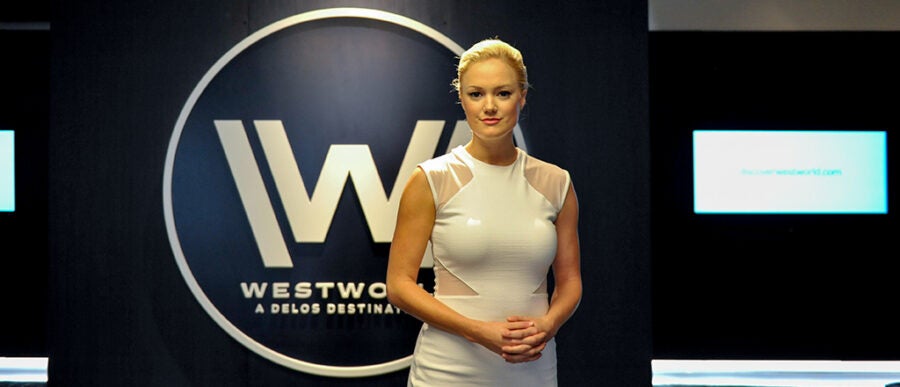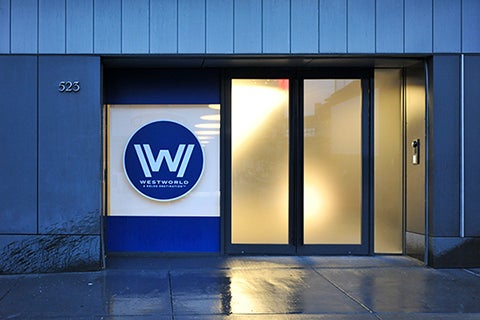
Knowledge at Wharton technology and media editor Kendall Whitehouse recently attended New York Comic Con where he explored what’s new in pop culture – and in media marketing. He reports on one particularly compelling immersive marketing experience at the event.
Virtual reality (VR) had a significant presence at ReedPop’s New York Comic Con this year. A dedicated exhibition space on the lower level of the Javits Center, dubbed the Experiential Zone, demonstrated a number of approaches to VR and immersive cinema for both entertainment and marketing.
One of the most compelling examples of using VR for a marketing experience didn’t take place inside the Javits Center, however. A half block away on West 37th Street, HBO’s Westworld VR Experience presented a combination physical environment and virtual experience to promote the network’s sci-fi series.
The Westworld VR Experience debuted a month earlier at TechCrunch Disrupt SF. At New York Comic Con, the virtual simulation was enhanced by a physical space that set the stage for the immersive experience.
Hybrid Physical/Virtual Environment
This type of hybrid physical/virtual environment has been featured in a number of recent high profile marketing “activations” (as the industry terms them). At this past summer’s San Diego Comic-Con, Amazon’s The Man in the High Castle VR Experience combined a virtual simulation with a constructed environment designed to recreate the world of the program. (The Man in the High Castle VR Experience was also present in New York Comic Con’s Experiential Zone, but without the physical installation preceding the VR experience.) The most notable recent blending of real world and virtual environments as part of a marketing activation was the Mr. Robot Virtual Reality Experience at San Diego Comic-Con. After entering a detailed reconstruction of the bedroom of the show’s protagonist, Elliot Alderson, you then enter a VR simulation that begins in the very room in which you’re sitting. It’s an uncanny sensation.
“As impressive as the simulation is, it has one constraint as a marketing tool: throughput.”
New York Comic Con’s Westworld activation presents a similar experience that transitions from the real world to the virtual.
A short distance from the Javits Center, a sleek facade with frosted glass doors displays the logo: “Westworld: A Delos Destination.” Inside you enter a lustrous black and glass corridor and are greeted by performers playing the role of Westworld’s “hosts,” the program’s synthetic humans. Dressed in white and speaking in eerily measured tones, the hosts welcome you to Westworld.
After a few introductory comments — and warnings about violence and nudity in the VR — you stand in the center of a black room, empty except for a chair in the corner. An assistant helps you don your HTC Vive VR headset and audio headphones, and you grasp your Vive controller. You’re also told that should you feel uncomfortable during the experience you can raise your hand and the assistant will help you end the experience (advice that’s both comforting yet somehow unnerving).
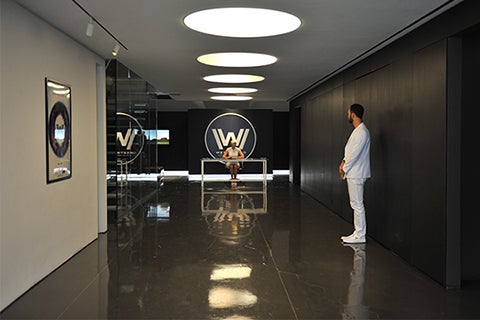
In many of these interactive simulations, including The Man in the High Castle Experience and the Mr. Robot VR Experience, the participant remains seated at the center of a 360-degree virtual environment. In the Westworld Experience, by contrast, you can move around to a limited degree within the environment. This can be disconcerting, since you’re moving through a physical space you can’t see. To avoid accidentally running into the walls, the simulation displays a series of bars floating in space if you move too close to the edge.
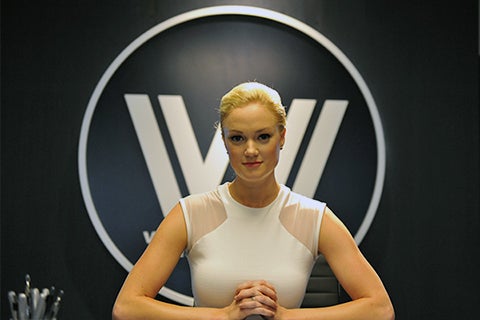
Entering Westworld
The Westworld simulation plays out over three brief tableaux. It begins with you entering a room where you select your weapon and decide whether you want to wear a white or a black hat. The simulation closely follows the scene in episode 2 of the program where new Westworld guest William (Jimmi Simpson) is presented with a similar set of choices. (When I went through the virtual experience, I hadn’t yet seen this episode. When I finally watched it, it gave me an eerie sense of déjà vu.)
After making these choices, you enter the western setting familiar from the show. A row of wooden buildings stands beside sandstone cliffs under a wide, blue sky. After picking up ammunition and loading your revolver, you engage in target practice by shooting bottles.
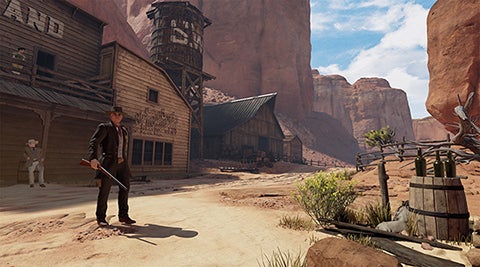
A sheriff then ambles over to recruit you to join a posse. But before that gets underway, the sheriff starts to “glitch” due to a “malfunction.” Something’s not right here.
You’re instructed to move over to the chair in the corner. (This is one of the more bizarre aspects of the simulation. Contacting a physical object in a space that you perceive through a virtual simulation is an odd experience.)
Once seated, the setting changes to the Delos lab where simulated humans are being created and repaired. With the ability to look in any direction, you can survey the entire scene. Things are “glitching’ here as well. Your vision falters and lights flash. There’s a commotion in the lab. A synthetic human is out of control. Things are clearly breaking down in Westworld.
Throughput Conundrum: Does It Scale?
As impressive as the simulation is, it has one constraint as a marketing tool: throughput. The interactive experience lasts 11 minutes. Allowing time for a brief introduction and exit, sessions are scheduled in 15 minute blocks. At New York Comic Con, there were two rooms that ran simultaneously. Thus, eight people per hour can participate in the experience, which runs for nine hours each day for a total of 72 people per day, or 288 participants throughout the four days of the convention.
This is obviously a small fraction of the attendees at the con. (Because New York Comic Con reports the number of tickets sold, rather than the number of unique individuals, it’s difficult to know exactly how many people attend the event.)
“As VR plays an expanding role in marketing, expect to see more of this layered approach to reach a broadest possible audience for these rich, interactive experiences.”
As I previously discussed in Knowledge at Wharton [ “Marketing at Comic-Con: Virtual Reality Melds with the Real World”] the approach taken by the Mr. Robot VR Experience may offer a more effective model for this type of marketing event. The 13-minute Mr. Robot simulation was launched at San Diego Comic-Con through a similar hybrid physical/virtual environment. [For more on the Mr. Robot Experience, see “The Mr. Robot VR Experience, Storytelling, and the Future of Immersive Media.”] The video was also available during an online simulcast for users with home VR systems such as Google Cardboard. Subsequently, it has been made available online in multiple formats for VR gear, mobile devices and desktop systems.
This approach leverages the buzz generated by the hardcore fans who attend Comic Con, while also gaining a larger audience through the simulcast, and then further expands the piece’s reach through the on-demand offerings.
As VR plays an expanding role in marketing, expect to see more of this layered approach to reach a broadest possible audience for these rich, interactive experiences.
For an extensive photo gallery of this year’s New York Comic Con, see Whitehouse’s Flickr photo album.
